Lamproptera curius (Fabricius, 1787) - ¿P»ñ½º - White Dragontail
| Distribution | The Butterfly | Voltinism | Food plant | Early stages | Conservation | Reference | Plates |
Lamproptera curius (Fabricius, 1787) - Lepidoptera: Papilionidae by James J. Young
Distribution
Lamproptera is a small genus and comprises of only 2 species. The distribution of Lamproptera curius covers a vast area from NE India, east to Sichuan, Hubei, Yunnan, Guangxi, Guandong and Hainan, south through Indochina and Malay Peninsula, Sumatra and Borneo and Palawan (BASCOMBE, JOHNSTON & BASCOMBE 1999). 3 subspecies are recognized (TSUKADA & NISHIYAMA 1980).
The Butterfly
Lamproptera curius is the smallest swallowtail in the whole Papilionidae family. The wings are generally black with white median band coupled with a large transparent area towards the margin of the forewings. It has a very long tail on each of its hindwing. The butterfly visits flowers and the male prefers to drink at puddles.
The butterfly may eject a jet of water from the tip of its abdomen while drinking so called pumping. Females are generally larger and have broader wings than the males. Seasonal forms do not appear to exist. The butterfly does not exhibit any hill topping behaviour.
Its flight can be very fast and erratic. It flies like a tiny dragonfly in flight and seems to be restless. It seldom comes to rest. They tend to fly around its host plant and will not wander far. The butterfly has two strongholds in Hong Kong noticeably in Fung Yuen, Tai Po and Po Lo Che in Sai Kung. The butterfly is also sighted in a few scattered locations both on the Hong Kong Island as well as in the New Territories. However, the number is very variable and may limit to one or two adults only. The butterfly is also found in San Tau Village, on the Lantau Island.
Voltinism
The butterfly is multivoltine. The butterfly is found as early as in February through to December each year. The number seems to increase from February onwards and has two peaks in population being one in June and July and the other in October and November. Dozens can be seen hovering over their host plant in search of the opposite sexes.
Food plant
The host plant is Illigera platyandra Dunn now Illigera celebica Miq. (Family Hernandiaceae). This plant is protected in Hong Kong under the Forestry Regulations Chapter 96, Subsidiary Legislation.
Early stages
The egg is spherical, greenish yellow in colour. It is laid singly on top of leaf usually on very young leaf. Larvae are typical of the Graphium species, swollen in the thoracic region. In the later instars, the larvae are greenish and smooth. The pupa is again greenish and is attached in an upright position by the cremaster attached to silken pad spun by the larva on the underside of leaf.
Conservation
The butterfly is very localized in Hong Kong and is found in a few scattered locations throughout Hong Kong. Its population seems to be very constant in the past 10 years or so and its known host plants are out of any redevelopment area and have been well preserved. There appears to have no immediate threat to the butterfly, as the butterfly is not vulnerable to any adverse factors over their range within Hong Kong.
Reference
1, BASCOMBE, M.J. JOHNSTON G. & BASCOMBE F.S. 1999 The Butterflies of Hong Kong, Academic Press, London, U.K. (page 141-142)
2, TSUKADA E. & NISHIYAMA Y. 1980 Butterflies of the South East Asian Islands, Volume I - Papilionidae, Plapac Co. Ltd., Tokyo, Japan. (page 432-433)
Plates
|
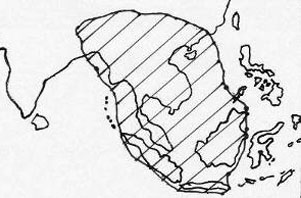
|
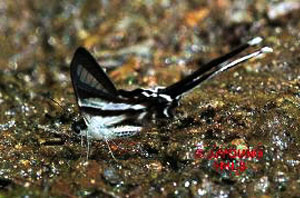
|
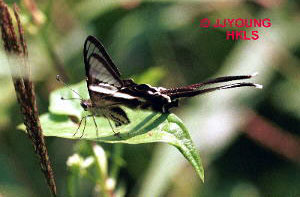
|
| Distribution map of Lamproptera curius (after TSUKADA & NISHIYAMA 1980) |
Male drinking at water puddles. (6/00 San Tau) |
Adult male resting. (6/00 San Tau & 11/98 Fung Yuen) |
|
|
|
|
|
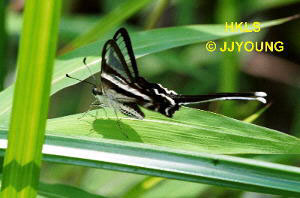
|
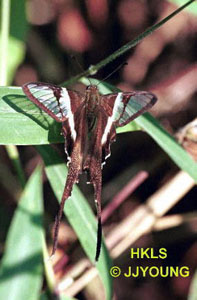
|
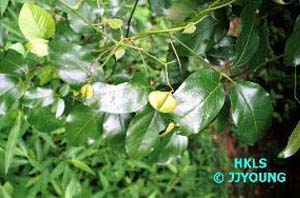 |
| Adult female resting. (6/00 San Tau & 11/98 Fung Yuen) |
Female resting. (top view 11/98 Fung Yuen) |
Flowers and seeds of Illigera celebica |
|
|
|
|
|
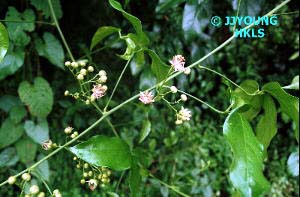
|
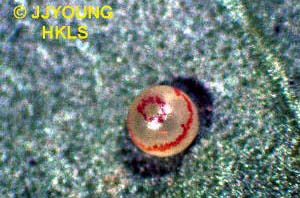
|
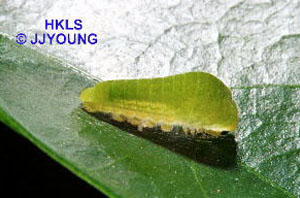
|
| Flowers and seeds of Illigera celebica |
Enlarged egg |
Final instar larva |
|
|
|
|
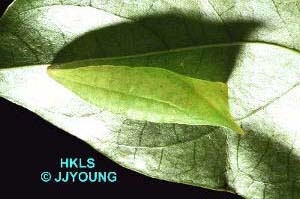
|
|
|
| Pupa on underside of leaf |
|
|
|
|
|
|
©2004 Hong Kong Lepidopterists' Society Limited
|